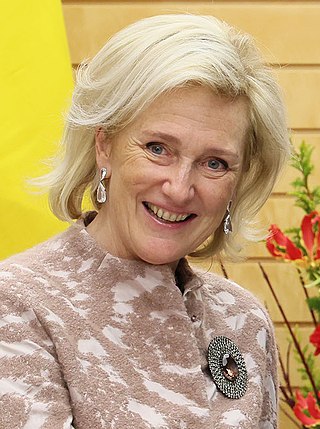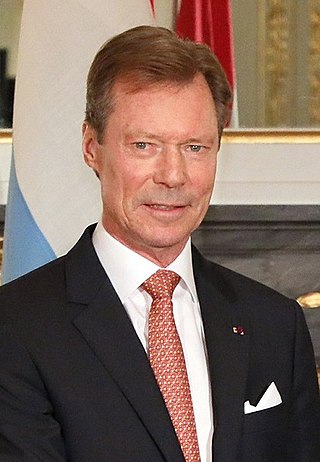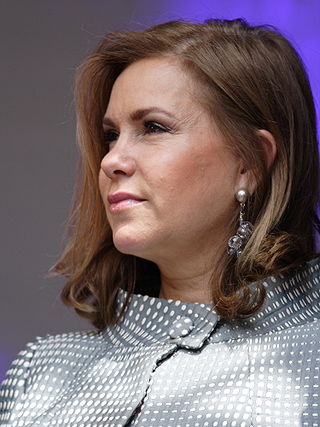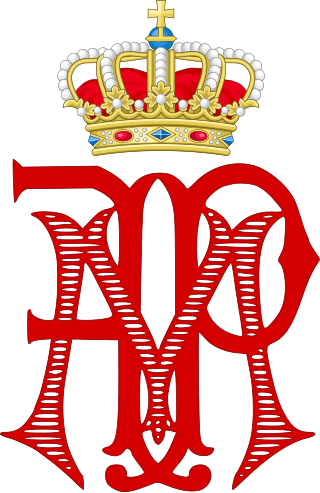The Grand Ducal Family of Luxembourg constitutes the House of Luxembourg-Nassau, headed by the sovereign Grand Duke, and in which the throne of the grand duchy is hereditary. It consists of heirs and descendants of the House of Nassau-Weilburg, whose sovereign territories passed cognatically from the House of Nassau to the House of Bourbon-Parma, itself a branch of the Spanish Royal House which is agnatically a cadet branch of the House of Capet that originated in France, itself a derivative dynasty from the Robertians and the founding house of the Capetian dynasty.

Princess Astrid of Belgium, Archduchess of Austria-Este, is the second child and first daughter of King Albert II and Queen Paola, and the younger sister to the current Belgian monarch, King Philippe. She is married to Prince Lorenz of Belgium, head of the Austria-Este branch of the House of Habsburg-Lorraine, and is fifth in line of succession to the Belgian throne.

Jean was the Grand Duke of Luxembourg from 1964 until his abdication in 2000. He was the first Grand Duke of Luxembourg of French agnatic descent.

Henri is Grand Duke of Luxembourg. He has reigned since 7 October 2000. Henri is the eldest son of Grand Duke Jean and Princess Joséphine-Charlotte of Belgium. He is a first cousin of King Philippe of Belgium. In 2019, Henri's net worth was estimated around US$4 billion.

Marie-Adélaïde, reigned as Grand Duchess of Luxembourg from 1912 until her abdication in 1919. She was the first Grand Duchess regnant of Luxembourg, its first female monarch since Duchess Maria Theresa and the first Luxembourgish monarch to be born within the territory since Count John the Blind (1296–1346).

Prince Guillaume, Hereditary Grand Duke of Luxembourg, is the heir apparent to the crown of Luxembourg since his father's accession in 2000.

Since 1983, the crown of the Netherlands passes according to absolute primogeniture. From 1814 until 1887, a monarch could only be succeeded by their closest female relative if there were no eligible male relatives. Male-preference cognatic primogeniture was adopted in 1887, though abolished when absolute primogeniture was introduced in 1983. Proximity of blood has been taken into consideration since 1922, when the constitution was changed to limit the line of succession to three degrees of kinship from the current monarch. In a situation where the monarch is succeeded by an eligible aunt or uncle, persons previously excluded could be reintroduced into the line of succession.

Prince Félix of Luxembourg, Prince of Bourbon-Parma and Prince of Nassau is the second son of Henri, Grand Duke of Luxembourg, and Maria Teresa, Grand Duchess of Luxembourg. He is currently fourth in the line of succession of Luxembourg.

Princess Alexandra of Luxembourg is the fourth child and only daughter of Henri, Grand Duke of Luxembourg, and Maria Teresa, Grand Duchess of Luxembourg. Alexandra is also "Princess of Nassau" and "Princess of Bourbon-Parma".

Maria Teresa is the Grand Duchess of Luxembourg as the wife of Grand Duke Henri, who acceded to the throne in 2000.
Imperial and Royal Highness is a style possessed by someone who either through birth or marriage holds two individual styles, Imperial Highness and Royal Highness. His/Her Imperial Highness is a style used by members of an imperial family to denote imperial – as opposed to royal – status to show that the holder is descended from an Emperor rather than a King or Queen. Holders of the style Imperial Highness generally rank above holders of the style Royal Highness.
Since 2011, the crown of Luxembourg descends according to absolute primogeniture among Grand Duke Henri's descendants and according to agnatic primogeniture among other dynasts.
The Spanish order of precedence is currently prescribed by Royal Decree 2099/1983. The decree establishes the order of precedence of national official activities as well as common regulations to activities organised by municipalities, autonomous communities and other public institutions. The general order established by the decree is modified if the event takes place in the capital, Madrid, instead of elsewhere in Spain.
The Grand Duchess Charlotte Maternity Hospital is a maternity hospital, part of the Centre Hospitalier de Luxembourg in Luxembourg. The hospital is named after Charlotte, Grand Duchess of Luxembourg, who reigned from 1919 to 1964.

Princess Stéphanie, Hereditary Grand Duchess of Luxembourg, is the wife of Hereditary Grand Duke Guillaume, the heir apparent to the throne of Luxembourg. She became engaged to the Hereditary Grand Duke on 26 April 2012 and married him, in a civil ceremony, on 19 October 2012, followed by a religious service the next day. The couple have two sons, Prince Charles and Prince François.

The wedding of Guillaume, Hereditary Grand Duke of Luxembourg, and Countess Stéphanie de Lannoy took place on 19 and 20 October 2012. A civil ceremony was held on 19 October followed by a Roman Catholic wedding ceremony at Notre-Dame Cathedral in Luxembourg City the next day. The 2012 wedding marked the largest event for the Grand Ducal Family of Luxembourg and the country in years. More than 120 international media organisations requested accreditation for the event, including TV channels and newspapers from China, Morocco, Russia and the US. Guillaume was the last unmarried heir apparent of a monarchy in Europe prior to the wedding.

The wedding of Prince Philippe, Duke of Brabant, and Mathilde d'Udekem d'Acoz took place on 4 December 1999 in Brussels, Belgium. The civil proceedings were conducted at Brussels Town Hall while the religious ceremony took place at the Cathedral of St. Michael and St. Gudula. The wedding has been described as the social event of the decade within Belgium and it was the last royal wedding of the second millennium.
The Belgian order of precedence is the formal ranking used at the Royal court during acts of state. Because the EU, NATO and SHAPE all have their headquarters in Belgium, this list is used every year during formal receptions at court.










